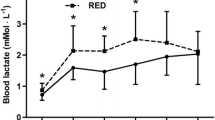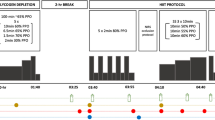Summary
The purpose of this investigation was to determine the effect of glycogen depletion and super-compensation on the physical working capacity at the fatigue threshold (PWCFT). Ten adult males (mean age 23 years, SD 3) volunteered as subjects for this study. During the first laboratory visit the subjects performed a maximal bicycle ergometer test for the determination of maximum oxygen consumption\(\left( {\dot V_{O_{2 max} } } \right)\). Between 48 and 72 h later, the subjects pedaled to exhaustion at a power output which corresponded to a mean of 76% of\(\left( {\dot V_{O_{2 max} } } \right)\) (range, 72–80%) for the purpose of glycogen depletion. For the next 3 days, the subjects were fed a 10.5 MJ · day−1 low carbohydrate diet which consisted of 7.5% carbohydrates, 22.0% protein and 70.5% fat. The subjects then performed an incremental cycle ergometer test to the onset of fatigue or PWCFT, which was estimated from integrated electromyographic voltages of the vastus lateralis muscle. For the next 3 days the subjects were fed a 10.5 MJ high carbohydrate diet which consisted of 72.2% carbohydrates, 12.4% protein and 15.4% fats for the purpose of glycogen supercompensation. The subjects then performed a second PWCFT test. A paired t-test indicated that there was no significant (p > 0.05) difference between the means of the PWCFT values (depletion 246 W, SD 30; supercompensation 265 W, SD 28) and they were highly correlated atr=0.884. The results of this investigation suggested that the methods commonly used to affect glycogen depletion or supercompensation had no effect on PWCFT.
Similar content being viewed by others
References
Adams CF, Richardson M (1981) Nutritive value of foods. United States Department of Agriculture, Washington, DC
Astrand PO (1956) Human physical fitness with special reference to sex and age. Physiol Rev 36:307–335
Bergstrom J, Hermansen L, Hultman E, Saltin B (1967) Diet, muscle glycogen and physical performance. Acta Physiol Scand 71:140–150
Bigland-Ritchie B, Woods JJ (1974) Integrated EMG and oxygen uptake during dynamic contractions of human muscles. J Appl Physiol 36:475–479
deVries HA, Moritani T, Nagata A, Magnussen K (1982) The relation between critical power and neuromuscular fatigue as estimated from electromyographic data. Ergonomics 25:783–791
deVries HA, Tichy MW, Housh TJ, Smyth KD, Tichy AM, Housh DJ (1987) A method for estimating physical working capacity at the fatigue threshold (PWCFT). Ergonomics 30:1195–1204
Donaldson SKB, Hermansen L, Bolles L (1978) Differential direct effects of H+ and Ca2+-activated force of skinned fibers from the soleus, cardiac and adductor magnus muscles of rabbits. Pflügers Arch 376:55–65
Edington DW, Ward GR, Saville WA (1971) Energy metabolism of working muscle: concentration profiles of selected metabolites. Am J Physiol 244:1375–1380
Fuchs F, Reddy Y, Briggs FN (1970) The interaction of cations with calcium binding site of troponin. Biochim Biophys Acta 221:407–409
Gibson H, Edwards RHT (1985) Muscular exercise and fatigue. Sports Med 2:120–132
Gollnick PD, Piehl K, Saltin B (1974) Selective glycogen depletion pattern in human muscle fibres after exercise of varying intensity and at varying pedaling rates. J Physiol (London) 241:45–57
Green HJ, Hughson RL, Orr GW, Ranney DA (1983) Anaerobic threshold, blood lactate, and muscle metabolites in progressive exercise. J Appl Physiol Respir Environ Exerc Physiol 54:1032–1038
Hagberg JM, Coyle EF, Carroll JE, Miller JM, Martin WH, Brooke MH (1982) Exercise hyperventilation in patients with McArdle's disease. J Appl Physiol Respir Environ Exerc Physiol 52:991–994
Housh TJ, deVries HA, Johnson GO, Tharp GD, Evans SA, Hughes RJ, Housh DJ (1989) The relationship between ventilatory threshold and the physical working capacity at the fatigue threshold. Abstracts of research presentations at the annual AAHPERD Convention, Boston. AAHPERD Publications, Reston, Virginia, pp 122
Hughes EF, Tunner SC, Brooks GA (1982) Effects of glycogen depletion and pedaling speed on “anaerobic threshold”. J Appl Physiol Respir Environ Exerc Physiol 52:1598–1607
Hultman E, Bergstrom J (1967) Muscle glycogen synthesis in relation to diet studied in normal subjects. Acta Med Scand 182:109–117
Hultman E, Bergstrom JH, Roch-Norlund AE (1971) Glycogen storage in human skeletal muscle. In: Pernow B, Saltin B (eds) Muscle metabolism during exercise. Plenum Press, New York, pp 273–288
Jones NL (1980) Hydrogen ion balance during exercise. Clin Sci 59:85–96
Katz A, Hecht H (1969) The early “pump” failure of the ischemic heart. Am J Med 47:497–502
Kostka CE, Cafarelli E (1982) Effect of pH on sensation and vastus lateralis electromyogram during cycle exercise. J Appl Physiol Respir Environ Exerc Physiol 52:1181–1185
Kowalchuk JM, Heigenhauser GJF, Jones NL (1984) Effect of pH on metabolic and cardiorespiratory responses during progressive exercise. J Appl Physiol Respir Environ Exerc Physiol 57:1558–1563
MaClaren DP, Gibson H, Parry-Billings M, Edwards RHT (1989) A review of metabolic and physiological factors in fatigue. In: Pandolph KB (ed) Exercise and sport science reviews. Williams and Wilkins, Baltimore, pp 29–66
Nakamura Y, Schuartz A (1970) Possible control of intracellular calcium metabolism by [H+]: sarcoplasmic reticulum of skeletal and cardiac muscle. Biochem Biophys Res Commun 41:330–386
Neary PJ, MacDougall JD, Bachus R, Wenger HA (1985) The relationship between lactate and ventilatory thresholds: Coincidental or cause and effect. Eur J Appl Physiol 54:104–108
Petrofsky JS (1979) Frequency and amplitude analysis of the EMG during exercise on the bicycle ergometer. Eur J Appl Physiol 41:1–15
Powers SK, Dodd S, Garner R (1984) Precision of ventilatory and gas exchange alterations as a predictor of the anaerobic threshold. Eur J Appl Physiol 52:173–177
Quirion A, Brisson GR, Laurencelle L, DeCarufel D, Audet A, Dulac S, Ledoux M, Vogelaere P (1988) Lactate threshold and onset of blood lactate accumulation during incremental exercise after dietary modifications. Eur J Appl Physiol 57:192–197
Saltin B, Karlsson J (1971) Muscle glycogen utilization during work of different intensities. In: Pernow B, Saltin B (eds) Muscle metabolism during exercise. Plenum Press, New York, pp 289–299
Simonson E (1971) Physiology of work capacity and fatigue. Thomas, Springfield, Ill.
Trentham DR, Eccleston JF, Bagshaw CR (1976) Kinetic analysis of ATPase mechanisms. Q Rev Biophys 9:217–281
Ui M (1966) A role of phosphofructokinase in pH dependent regulation of glycolysis. Biochim Biophys Acta 124:310–322
Yoshida T (1984) Effect of dietary modifications on lactate threshold and onset of blood lactate accumulation during incremental exercise. Eur J Appl Physiol 53:200–205
Yoshida T (1986) Effect of dietary modifications on anaerobic threshold. Sports Med 3:4–9
Author information
Authors and Affiliations
Rights and permissions
About this article
Cite this article
Housh, T.J., deVries, H.A., Johnson, G.O. et al. The effect of glycogen depletion and supercompensation on the physical working capacity at the fatigue threshold. Europ. J. Appl. Physiol. 60, 391–394 (1990). https://doi.org/10.1007/BF00713505
Accepted:
Issue Date:
DOI: https://doi.org/10.1007/BF00713505




